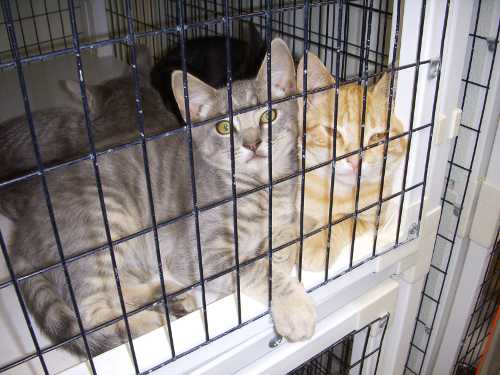
LAKEPORT, Calif. – Everyone has seen them – and many have fed them – but community members learned at a presentation last Friday the depth and scope of the feral and unowned cat problem in Lake County.
The startling truth: Lake County euthanizes more cats per capita than any other county in the state.
“We knew it was a big problem,” said Lake County Animal Care and Control Director Bill Davidson, “but after this, we began realizing just how big the problem was.”
The June 24 presentation was given by Dr. Richard Bachman, DVM, director of Veterinary Services for Contra Costa County and owner/operator of Shelter Medicine Support, a veterinary consulting and services group.
Nearly 30 community members were in attendance to learn steps that Lake County can take to address the estimated 11,000 free-roaming cats, which will help protect the estimated 11,900 owned cats here.
“Control of community cats is one of the most controversial issues in animal welfare,” Bachman said.
Bachman came to Lake County recently to visit the county's shelter facility on Helbush Drive in Lakeport and evaluate the possibility that the department could sustain an in-house medical program to help change the statistics on euthanasia.
In Lake County, the euthanasia rate of cats and dogs is 44.7 per 1,000 human population – placing the county at No. 1 statewide.
The euthanasia rate for cats alone in Lake County is 37.2 per 1,000, while the state average is 11.5 per 1,000.
Rates in neighboring counties are much lower. Napa and Mendocino counties are at 10.2 and 9.9 respectively, with Sonoma at 14.0, according to Bachman.
“In most communities, there are feral cats,” said Bachman.
He described ferals as cats that take care of themselves and do not seek human assistance, as well as “community cats” – or cats that go house to house begging for scraps, but who are not owned, nor taken to a veterinarian for shots or sterilization by anyone.
“Fifty percent of the feeders of community cats do not own cats themselves,” he said.
Cats are the only animal species that have domesticated themselves, Bachman stated, “and they began doing so over 10,000 years ago.”
Physiologically, cats have “obligatory ovulation,” meaning a cat will stay in heat and able to conceive kittens until it breeds, giving them, “an average of 1.4 litters … of three kittens … per year,” Bachman explained.
“In the United States, there are 82 to 88 million owned cats,” Bachman said.
Of those owned cats, Bachman said 80 to 85 percent are sterilized. However, there also are 80 to 90 million community cats, with the same number born each year. “So you see the problem,” he said.
The bottom line, Bachman explained, is that euthanizing and disposing of animals is expensive – and not what a community wants to be known for doing.
Nonlethal control of unwanted pet populations must be, “of adequate scale to manage the size of the unknown at population, safe for the environment, affordable, sustainable, and acceptable to the public,” Bachman explained.
At shelters, truly feral cats that are brought in are often euthanized as “unhealthy” under the “Asilomar Accords.”
The accords were devised in August of 2004, when a group of animal welfare industry leaders from across the nation convened at Asilomar in Pacific Grove, Calif., to focus on significantly reducing the euthanasia of healthy and treatable companion animals in the United States, Bachman said.
However, many times, “Princess” – a well-loved cat now under stress – also is brought in to a shelter and labeled “feral,” then euthanized, according to Bachman, who suggested that nonlethal measures and programs be established.
Bachman outlined several successful models of “TNR” (trap, neuter and return/release), combined with vaccinating for rabies and “tipping” the cats' ear so they can be easily identified as sterile. He noted studies that showed a decrease in community cat populations when such models are used.
“Live release is a morale booster for shelter staff and the community,” Bachman said, “because you are not killing cats.”
Given the size of the problem in Lake County, and that “cat season” is well under way once again, Davidson asked Bachman, “Where do we begin?”
Davidson said this week that one of his next steps is to pursue grant funding for spaying and neutering feral cats.
He said every veterinarian he's spoken to around the county has agreed to do low-cost spaying and neutering for feral cats in support of an effort to address the problem.
In addition, a quarter of the people who have brought feral cats in have indicated that they would keep the animals if there were low-cost services available, he said.
Trap and release programs, such as Bachman discussed, need to have someone who is willing to oversee a cat colony with a place to do it. Davidson said grants could help fund such efforts.
E-mail Terre Logsdon at This email address is being protected from spambots. You need JavaScript enabled to view it.. Follow Lake County News on Twitter at http://twitter.com/LakeCoNews, on Tumblr at www.lakeconews.tumblr.com, on Facebook at http://www.facebook.com/pages/Lake-County-News/143156775604?ref=mf and on YouTube at http://www.youtube.com/user/LakeCoNews .

 How to resolve AdBlock issue?
How to resolve AdBlock issue? 






